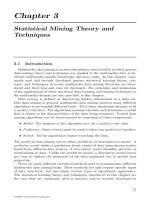Data mining cookbook (2001)
Bạn đang xem bản rút gọn của tài liệu. Xem và tải ngay bản đầy đủ của tài liệu tại đây (5.7 MB, 429 trang )
TEAMFLY
Team-Fly
®
Page iii
Data Mining Cookbook
Modeling Data for Marketing, Risk, and Customer Relationship Management
Olivia Parr Rud
Page iv
Publisher: Robert Ipsen
Editor: Robert M. Elliott
Assistant Editor: Emilie Herman
Managing Editor: John Atkins
Associate New Media Editor: Brian Snapp
Text Design & Composition: Argosy
Designations used by companies to distinguish their products are often claimed as trademarks. In all instances where
John Wiley & Sons, Inc., is aware of a claim, the product names appear in initial capital or ALL CAPITAL LETTERS.
Readers, however, should contact the appropriate companies for more complete information regarding trademarks and
registration.
Copyright © 2001 by Olivia Parr Rud. All rights reserved.
Published by John Wiley & Sons, Inc.
No part of this publication may be reproduced, stored in a retrieval system or transmitted in any form or by any means,
electronic, mechanical, photocopying, recording, scanning or otherwise, except as permitted under Sections 107 or 108
of the 1976 United States Copyright Act, without either the prior written permission of the Publisher, or authorization
through payment of the appropriate per-
copy fee to the Copyright Clearance Center, 222 Rosewood Drive, Danvers, MA
01923, (978) 750-8400, fax (978) 750-4744. Requests to the Publisher for permission should be addressed to the
Permissions Department, John Wiley & Sons, Inc., 605 Third Avenue, New York, NY 10158-0012, (212) 850-6011, fax
(212) 850-6008, E-Mail: PERMREQ @ WILEY.COM.
This publication is designed to provide accurate and authoritative information in regard to the subject matter covered. It
is sold with the understanding that the publisher is not engaged in professional services. If professional advice or other
expert assistance is required, the services of a competent professional person should be sought.
This title is also available in print as 0-471-38564-6
For more information about Wiley product, visit our web site at www.Wiley.com.
Page v
What People Are Saying about Olivia Parr Rud's Data Mining Cookbook
In the Data Mining Cookbook, industry expert Olivia Parr Rud has done the impossible: She has made a very complex
process easy for the novice to understand. In a step-by-step process, in plain English, Olivia tells us how we can benefit
from modeling, and how to go about it. It's like an advanced graduate course boiled down to a very friendly, one-on-one
conversation. The industry has long needed such a useful book.
Arthur Middleton Hughes
Vice President for Strategic Planning,
M\S Database Marketing
This book provides extraordinary organization to modeling customer behavior. Olivia Parr Rud has made the subject
usable, practical, and fun. . . . Data Mining Cookbook is an essential resource for companies aspiring to the best strategy
for success— customer intimacy.
William McKnight
President, McKnight Associates, Inc
.
In today's digital environment, data flows at us as though through a fire hose. Olivia Parr Rud's Data Mining Cookbook
satisfies the thirst for a user-friendly "cookbook" on data mining targeted at analysts and modelers responsible for
serving up insightful analyses and reliable models.
Data Mining Cookbook includes all the ingredients to make it a valuable resource for the neophyte as well as the
experienced modeler. Data Mining Cookbook starts with the basic ingredients, like the rudiments of data analysis, to
ensure that the beginner can make sound interpretations of moderate-
sized data sets. She finishes up with a closer look at
the more complex statistical and artificial intelligence methods (with reduced emphasis on mathematical equations and
jargon, and without computational formulas), which gives the advanced modeler an edge in developing the best possible
models.
Bruce Ratner
Founder and President, DMStat1
Page vii
To Betty for her strength and drive.
To Don for his intellect.
Page ix
CONTENTS
Acknowledgments xv
Foreword xvii
Introduction xix
About the Author
xxiii
About the Contributors xxv
Part One: Planning the Menu 1
Chapter 1: Setting the Objective 3
Defining the Goal
4
Profile Analysis 7
Segmentation 8
Response 8
Risk
9
Activation 10
Cross-Sell and Up-Sell 10
Attrition 10
Net Present Value
11
Lifetime Value
11
Choosing the Modeling Methodology 12
Linear Regression 12
Logistic Regression 15
Neural Networks
16
Genetic Algorithms 17
Classification Trees 19
The Adaptive Company 20
Hiring and Teamwork 21
Product Focus versus Customer Focus
22
Summary 23
Chapter 2: Selecting the Data Sources 25
Types of Data 26
Sources of Data
27
Internal Sources 27
External Sources 36
Selecting Data for Modeling 36
Data for Prospecting 37
Data for Customer Models
40
Data for Risk Models 42
Constructing the Modeling Data Set 44
How big should my sample be? 44
Page x
Sampling Methods
45
Developing Models from Modeled Data 47
Combining Data from Multiple Offers 47
Summary 48
Part Two: The Cooking Demonstration 49
Chapter 3: Preparing the Data for Modeling
51
Accessing the Data 51
Classifying Data 54
Reading Raw Data 55
Creating the Modeling Data Set
57
Sampling 58
Cleaning the Data 60
Continuous Variables 60
Categorical Variables
69
Summary 70
Chapter 4: Selecting and Transforming the Variables 71
Defining the Objective Function 71
Probability of Activation 72
Risk Index
73
Product Profitability 73
Marketing Expense 74
Deriving Variables 74
Summarization
74
Ratios 75
Dates 75
Variable Reduction 76
Continuous Variables 76
Categorical Variables
80
Developing Linear Predictors 85
Continuous Variables 85
Categorical Variables 95
Interactions Detection
98
Summary 99
Chapter 5: Processing and Evaluating the Model 101
Processing the Model 102
Splitting the Data 103
Method 1: One Model
108
Method 2: Two Models— Response 119
Page xi
Method 2: Two Models
—
Activation
119
Comparing Method 1 and Method 2 121
Summary 124
Chapter 6: Validating the Model 125
Gains Tables and Charts 125
Method 1: One Model
126
Method 2: Two Models 127
Scoring Alternate Data Sets 130
Resampling 134
Jackknifing
134
Bootstrapping 138
Decile Analysis on Key Variables 146
Summary 150
Chapter 7: Implementing and Maintaining the Model
151
Scoring a New File 151
Scoring In-house 152
Outside Scoring and Auditing 155
Implementing the Model 161
Calculating the Financials
161
Determining the File Cut-off 166
Champion versus Challenger 166
The Two-Model Matrix 167
Model Tracking
170
Back-end Validation 176
Model Maintenance 177
Model Life 177
Model Log 178
Summary
179
Part Three: Recipes for Every Occasion 181
Chapter 8: Understanding Your Customer: Profiling and Segmentation 183
What is the importance of understanding your customer? 184
Types of Profiling and Segmentation
184
Profiling and Penetration Analysis of a Catalog Company's
Customers
190
RFM Analysis 190
Penetration Analysis 193
Developing a Customer Value Matrix for a Credit
TEAMFLY
Team-Fly
®
Page xii
Card Company
198
Customer Value Analysis 198
Performing Cluster Analysis to Discover Customer Segments 203
Summary 204
Chapter 9: Targeting New Prospects: Modeling Response 207
Defining the Objective
207
All Responders Are Not Created Equal 208
Preparing the Variables 210
Continuous Variables 210
Categorical Variables
218
Processing the Model 221
Validation Using Boostrapping 224
Implementing the Model 230
Summary
230
Chapter 10: Avoiding High-Risk Customers: Modeling Risk 231
Credit Scoring and Risk Modeling 232
Defining the Objective 234
Preparing the Variables 235
Processing the Model
244
Validating the Model 248
Bootstrapping 249
Implementing the Model 251
Scaling the Risk Score
252
A Different Kind of Risk: Fraud 253
Summary 255
Chapter 11: Retaining Profitable Customers: Modeling Churn 257
Customer Loyalty 258
Defining the Objective
258
Preparing the Variables 263
Continuous Variables 263
Categorical Variables 265
Processing the Model
268
Validating the Model 270
Bootstrapping 271
Page xiii
Implementing the Model
273
Creating Attrition Profiles 273
Optimizing Customer Profitability 276
Retaining Customers Proactively 278
Summary 278
Chapter 12: Targeting Profitable Customers: Modeling Lifetime Value
281
What is lifetime value? 282
Uses of Lifetime Value 282
Components of Lifetime Value 284
Applications of Lifetime Value
286
Lifetime Value Case Studies 286
Calculating Lifetime Value for a Renewable Product or Service 290
Calculating Lifetime Value: A Case Study 290
Case Study: Year One Net Revenues
291
Lifetime Value Calculation 298
Summary 303
Chapter 13: Fast Food: Modeling on the Web 305
Web Mining and Modeling 306
Defining the Objective
306
Sources of Web Data 307
Preparing Web Data 309
Selecting the Methodology 310
Branding on the Web
316
Gaining Customer Insight in Real Time 317
Web Usage Mining— A Case Study 318
Summary 322
Appendix A: Univariate Analysis for Continuous Variables 323
Appendix B: Univariate Analysis of Categorical Variables
347
Recommended Reading 355
What's on the CD-ROM? 357
Index 359
Page xv
ACKNOWLEDGMENTS
A few words of thanks seem inadequate to express my appreciation for those who have supported me over the last year.
I had expressed a desire to write a book on this subject for many years. When the opportunity became a reality, it
required much sacrifice on the part of my family. And as those close to me know, there were other challenges to face. So
it is a real feeling of accomplishment to present this material.
First of all, I'd like to thank my many data sources, all of which have chosen to remain anonymous. This would not have
been possible without you.
During the course of writing this book, I had to continue to support my family. Thanks to Jim Sunderhauf and the team
at Analytic Resources for helping me during the early phases of my writing. And special thanks to Devyani Sadh for
believing in me and supporting me for a majority of the project.
My sincere appreciation goes to Alan Rinkus for proofing the entire manuscript under inhumane deadlines.
Thanks to Ruth Rowan and the team at Henry Stewart Conference Studies for giving me the opportunity to talk to
modelers around the world and learn their interests and challenges.
Thanks to the Rowdy Mothers, many of whom are authors yourselves. Your encouragement and writing tips were
invaluable.
Thanks to the editorial team at John Wiley & Sons, including Bob Elliott, Dawn Kamper, Emilie Herman, John Atkins,
and Brian Snapp. Your gentle prodding and encouragement kept me on track most of the time.
Finally, thanks to Brandon, Adam, Vanessa, and Dean for tolerating my unavailability for the last year.
Page xvii
FOREWORD
I am a data miner by vocation and home chef by avocation, so I was naturally intrigued when I heard about Olivia Parr
Rud's Data Mining Cookbook. What sort of cookbook would it be, I wondered? My own extensive and eclectic cookery
collection is comprised of many different styles. It includes lavishly illustrated coffee-table books filled with lush
photographs of haute cuisine classics or edible sculptures from Japan's top sushi chefs. I love to feast my eyes on this
sort of culinary erotica, but I do not fool myself that I could reproduce any of the featured dishes by following the
skimpy recipes that accompany the photos! My collection also includes highly specialized books devoted to all the
myriad uses for a particular ingredient such as mushrooms or tofu. There are books devoted to the cuisine of a particular
country or region; books devoted to particular cooking methods like steaming or barbecue; books that comply with the
dictates of various health, nutritional or religious regimens; even books devoted to the use of particular pieces of kitchen
apparatus. Most of these books were gifts. Most of them never get used.
But, while scores of cookbooks sit unopened on the shelf, a few— Joy of Cooking, Julia Child— have torn jackets and
colored Post-its stuck on many pages. These are practical books written by experienced practitioners who understand
both their craft and how to explain it. In these favorite books, the important building blocks and basic techniques
(cooking flour and fat to make a roux
; simmering vegetables and bones to make a stock; encouraging yeast dough to rise
and knowing when to punch it down, knead it, roll it, or let it rest) are described step by step with many illustrations.
Often, there is a main recipe to illustrate the technique followed by enough variations to inspire the home chef to
generalize still further.
I am pleased to report that Olivia Parr Rud has written just such a book. After explaining the role of predictive and
descriptive modeling at different stages of the customer lifecycle, she provides case studies in modeling response, risk,
cross-selling, retention, and overall profitability. The master recipe is a detailed, step-by-
step exploration of a net present
value model for a direct-mail life insurance marketing campaign. This is an excellent example because it requires
combining estimates for response, risk, expense, and profitability, each of which is a model in its own right. By
following the master recipe, the reader gets a thorough introduction to every step in the data mining process,
Page xviii
from choosing an objective function to selecting appropriate data, transforming it into usable form, building a model set,
deriving new predictive variables, modeling, evaluation, and testing. Along the way, even the most experienced data
miner will benefit from many useful tips and insights that the author has gleaned from her many years of experience in
the field.
At Data Miners, the analytic marketing consultancy I founded in 1997, we firmly believe that data mining projects
succeed or fail on the basis of the quality of the data mining process and the suitability of the data used for mining. The
choice of particular data mining techniques, algorithms, and software is of far less importance. It follows that the most
important part of a data mining project is the careful selection and preparation of the data, and one of the most important
skills for would-be data miners to develop is the ability to make connections between customer behavior and the tracks
and traces that behavior leaves behind in the data. A good cook can turn out gourmet meals on a wood stove with a
couple of cast iron skillets or on an electric burner in the kitchenette of a vacation condo, while a bad cook will turn out
mediocre dishes in a fancy kitchen equipped with the best and most expensive restaurant-quality equipment. Olivia Parr
Rud understands this. Although she provides a brief introduction to some of the trendier data mining techniques, such as
neural networks and genetic algorithms, the modeling examples in this book are all built in the SAS programming
language using its logistic regression procedure. These tools prove to be more than adequate for the task.
This book is not for the complete novice; there is no section offering new brides advice on how to boil water. The reader
is assumed to have some knowledge of statistics and analytical modeling techniques and some familiarity with the SAS
language, which is used for all examples. What is not assumed is familiarity with how to apply these tools in a data
mining context in order to support database marketing and customer relationship management goals. If you are a
statistician or marketing analyst who has been called upon to implement data mining models to increase response rates,
increase profitability, increase customer loyalty or reduce risk through data mining, this book will have you cooking up
great models in no time.
MICHAEL J. A. BERRY
FOUNDER, DATA MINERS, INC
CO-AUTHOR, DATA MINING TECHNIQUES AND
MASTERING DATA MINING
Page xix
INTRODUCTION
What is data mining?
Data mining is a term that covers a broad range of techniques being used in a variety of industries. Due to increased
competition for profits and market share in the marketing arena, data mining has become an essential practice for
maintaining a competitive edge in every phase of the customer lifecycle.
Historically, one form of data mining was also known as ''data dredging." This was considered beneath the standards of
a good researcher. It implied that a researcher might actually search through data without any specific predetermined
hypothesis. Recently, however, this practice has become much more acceptable, mainly because this form of data
mining has led to the discovery of valuable nuggets of information. In corporate America, if a process uncovers
information that increases profits, it quickly gains acceptance and respectability.
Another form of data mining began gaining popularity in the marketing arena in the late 1980s and early 1990s. A few
cutting edge credit card banks saw a form of data mining, known as data modeling, as a way to enhance acquisition
efforts and improve risk management. The high volume of activity and unprecedented growth provided a fertile ground
for data modeling to flourish. The successful and profitable use of data modeling paved the way for other types of
industries to embrace and leverage these techniques. Today, industries using data modeling techniques for marketing
include insurance, retail and investment banking, utilities, telecommunications, catalog, energy, retail, resort, gaming,
pharmaceuticals, and the list goes on and on.
What is the focus of this book?
There are many books available on the statistical theories that underlie data modeling techniques. This is not one of
them! This book focuses on the practical knowledge needed to use these techniques in the rapidly evolving world of
marketing, risk, and customer relationship management (CRM).
Page xx
Most companies are mystified by the variety and functionality of data mining software tools available today. Software
vendors are touting "ease of use" or "no analytic skills necessary." However, those of us who have been working in this
field for many years know the pitfalls inherent in these claims. We know that the success of any modeling project
requires not only a good understanding of the methodologies but solid knowledge of the data, market, and overall
business objectives. In fact, in relation to the entire process, the model processing is only a small piece.
The focus of this book is to detail clearly and exhaustively the entire model development process. The details include the
necessary discussion from a business or marketing perspective as well as the intricate SAS code necessary for
processing. The goal is to emphasize the importance of the steps that come before and after the actual model processing.
Who should read this book?
As a result of the explosion in the use of data mining, there is an increasing demand for knowledgeable analysts or data
miners to support these efforts. However, due to a short supply, companies are hiring talented statisticians and/or junior
analysts who understand the techniques but lack the necessary business acumen. Or they are purchasing comprehensive
data mining software tools that can deliver a solution with limited knowledge of the analytic techniques underlying it or
the business issues relevant to the goal. In both cases, knowledge may be lacking in essential areas such as structuring
the goal, obtaining and preparing the data, validating and applying the model, and measuring the results. Errors in any
one of these areas can be disastrous and costly.
The purpose of this book is to serve as a handbook for analysts, data miners, and marketing managers at all levels. The
comprehensive approach provides step-by-step instructions for the entire data modeling process, with special emphasis
on the business knowledge necessary for effective results. For those who are new to data mining, this book serves as a
comprehensive guide through the entire process. For the more experienced analyst, this book serves as a handy
reference. And finally, managers who read this book gain a basic understanding of the skills and processes necessary to
successfully use data models.
Page xxi
How This Book Is Organized
The book is organized in three parts. Part One lays the foundation. Chapter 1 discusses the importance of determining
the goal or clearly defining the objective from a business perspective. Chapter 2 discusses and provides numerous cases
for laying the foundation. This includes gathering the data or creating the modeling data set. Part Two details each step
in the model development process through the use of a case study. Chapters 3 through 7 cover the steps for data cleanup,
variable reduction and transformation, model processing, validation, and implementation. Part Three offers a series of
case studies that detail the key steps in the data modeling process for a variety of objectives, including profiling,
response, risk, churn, and lifetime value for the insurance, banking, telecommunications, and catalog industries.
As the book progresses through the steps of model development, I include suitable contributions from a few industry
experts who I consider to be pioneers in the field of data mining. The contributions range from alternative perspectives
on a subject such as multi-collinearity to additional approaches for building lifetime value models.
Tools You Will Need
To utilize this book as a solution provider, a basic understanding of statistics is recommended. If your goal is to generate
ideas for uses of data modeling from a managerial level then good business judgement is all you need. All of the code
samples are written in SAS. To implement them in SAS, you will need Base SAS and SAS/STAT. The spreadsheets are
in Microsoft Excel. However, the basic logic and instruction are applicable to all software packages and modeling tools.
The Companion CD
-
ROM
Within chapters 3 through 12 of this book are blocks of SAS code used to develop, validate, and implement the data
models. By adapting this code and using some common sense, it is possible to build a model from the data preparation
phase through model development and validation. However, this could take a considerable amount of time and introduce
the possibility of coding errors. To simplify this task and make the code easily accessible for a variety of model types, a
companion CD-ROM is available for purchase separately.
TEAMFLY
Team-Fly
®
Page xxii
The CD-ROM includes full examples of all the code necessary to develop a variety of models, including response,
approval, attrition or churn, risk, and lifetime or net present value. Detailed code for developing the objective function
includes examples from the credit cards, insurance, telecommunications, and catalog industries. The code is well
documented and explains the goals and methodology for each step. The only software needed is Base SAS and
SAS/STAT.
The spreadsheets used for creating gains tables and lift charts are also included. These can be used by plugging in the
preliminary results from the analyses created in SAS.
While the steps before and after the model processing can be used in conjunction with any data modeling software
package, the code can also serve as a stand-alone modeling template. The model processing steps focus on variable
preparation for use in logistic regression. Additional efficiencies in the form of SAS macros for variable processing and
validation are included.
What Is Not Covered in This Book
A book on data mining is really not complete without some mention of privacy. I believe it is a serious part of the work
we do as data miners. The subject could fill an entire book. So I don't attempt to cover it in this book. But I do encourage
all companies that use personal data for marketing purposes to develop a privacy policy. For more information and some
simple guidelines, contact the Direct Marketing Association at (212) 790-1500 or visit their Web site at www.the-
dma.org
.
Summary
Effective data mining is a delicate blend of science and art. Every year, the number of tools available for data mining
increases. Researchers develop new methods, software manufacturers automate existing methods, and talented analysts
continue to push the envelope with standard techniques. Data mining and, more specifically, data modeling, is becoming
a strategic necessity for companies to maintain profitability. My desire for this book serves as a handy reference and a
seasoned guide as you pursue your data mining goals.
Page xxiii
ABOUT THE AUTHOR
Olivia Parr Rud is executive vice president of Data Square, LLC. Olivia has over 20 years' experience in the financial
services industry with a 10-year emphasis in data mining, modeling, and segmentation for the credit card, insurance,
telecommunications, resort, retail, and catalog industries. Using a blend of her analytic skills and creative talents, she has
provided analysis and developed solutions for her clients in the areas of acquisition, retention, risk, and overall
profitability.
Prior to joining Data Square, Olivia held senior management positions at Fleet Credit Card Bank, Advanta Credit Card
Bank, National Liberty Insurance, and Providian Bancorp. In these roles, Olivia helped to integrate analytic capabilities
into every area of the business, including acquisition, campaign management, pricing, and customer service.
In addition to her work in data mining, Olivia leads seminars on effective communication and managing transition in the
workplace. Her seminars focus on the personal challenges and opportunities of working in a highly volatile industry and
provide tools to enhance communication and embrace change to create a "win
-
win" environment.
Olivia has a BA in Mathematics from Gettysburg College and an MS in Decision Science, with an emphasis in statistics,
from Arizona State University. She is a frequent speaker at marketing conferences on data mining, database design,
predictive modeling, Web modeling and marketing strategies.
Data Square is a premier database marketing consulting firm offering business intelligence solutions through the use of
cutting-edge analytic services, database design and management, and e-
business integration. As part of the total solution,
Data Square offers Web-enabled data warehousing, data marting, data mining, and strategic consulting for both
business-to-business and business-to-consumer marketers and e-marketers.
Data Square's team is comprised of highly skilled analysts, data specialists, and marketing experts who collaborate with
clients to develop fully integrated CRM and eCRM strategies from acquisition and cross-sell/up-sell to retention, risk,
and lifetime value. Through profiling, segmentation, modeling, tracking, and testing, the team at Data Square provides
total business intelligence solutions
Page xxiv
for maximizing profitability. To find more about our Marketing Solutions: Driven by Data, Powered by Strategy
, visit us
at www.datasquare.com or call (203) 964-9733.
Page xxv
ABOUT THE CONTRIBUTORS
Jerry Bernhart is president of Bernhart Associates Executive Search, a nationally recognized search firm concentrating
in the fields of database marketing and analysis. Jerry has placed hundreds of quantitative analysts since 1990. A well-
known speaker and writer, Jerry is also a nominated member of The Pinnacle Society, an organization of high achievers
in executive search. Jerry is a member DMA, ATA, NYDMC, MDMA, CADM, TMA, RON, IPA, DCA, US-
Recruiters.com, and The Pinnacle Group (pending).
His company, Bernhart Associates Executive Search, concentrates exclusively in direct marketing, database marketing,
quantitative analysis, and telemarketing management. You can find them on the Internet at www.bernhart.com. Jerry is
also CEO of directmarketingcareers.com, the Internet's most complete employment site for the direct marketing
industry. Visit .
William Burns has a Ph.D. in decision science and is currently teaching courses related to statistics and decision
making at Cal State San Marcos. Formerly he was a marketing professor at UC-Davis and the University of Iowa. His
research involves the computation of customer lifetime value as a means of making better marketing decisions. He also
is authoring a book on how to apply decision-making principles in the selection of romantic relationships. He can be
reached at
Mark Van Clieaf is managing director of MVC Associates International. He leads this North American consulting
boutique that specializes in organization design and executive search in information-based marketing, direct marketing,
and customer relationship management. Mark has led a number of research studies focused on best practices in CRM, e-
commerce and the future of direct and interactive marketing. These studies and articles can be accessed at
www.mvcinternational.com
. He works with a number of leading Fortune 500 companies as part of their e-
commerce and
CRM strategies.
Allison Cornia is database marketing manager for the CRM/Home and Retail Division of Microsoft Corporation. Prior
to joining Microsoft, Allison held the position of vice president of analytic services for Locus Direct Marketing Group,
where she led a group of statisticians, programmers, and project managers in developing customer solutions for database
marketing programs in a





![data mining and machine learning in cybersecurity [electronic resource]](https://media.store123doc.com/images/document/14/y/op/medium_hJlflZCPev.jpg)



